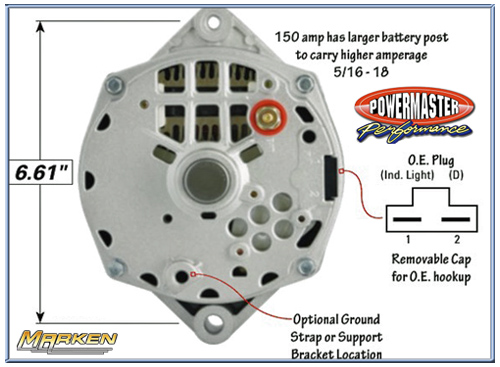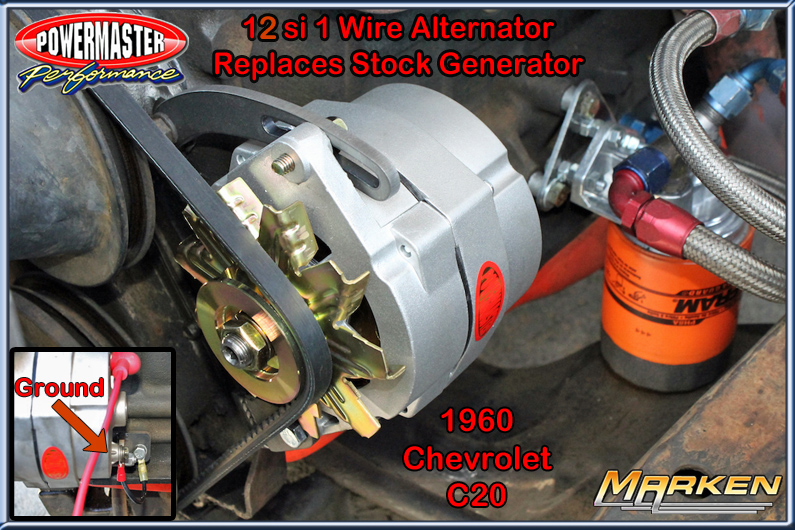Shop Powermaster Alternators & Starters, Marken Performance 1-888-401-1362
Powermaster supplies Marken Performance with alternators and starters for everyday use or racing. Powermaster's 12si family of alternators is not only a great high output replacement for early GM 10dn and 10si alternators, but they work remarkably well in the generator to alternator conversions. The one-wire alternator, identified by the single post in the rear of the unit, is the easiest to install and wire into an existing charging system. A generator creates energy by rotating a conductor inside a stationary magnetic field. Alternators create their movable energy more efficiently by rotating a magnetic field inside conductors.
 3-wire alternators begin working when the ignition switch is turned on whereas 1 wire alternators work as soon as the sensing circuit built in the internal voltage regulator senses rotation of the alternator’s rotor.
3-wire alternators begin working when the ignition switch is turned on whereas 1 wire alternators work as soon as the sensing circuit built in the internal voltage regulator senses rotation of the alternator’s rotor.
A 1-wire alternator has a turn on point (sometimes called “cut in”, which is typically 1200 engine RPM’s). This is the speed where the internal sense circuitry connects the battery to the voltage regulator, thereby turning the alternator on. Once the voltage regulator turns on, the alternator will remain on and charging until the engine comes to a complete stop. Many of the Powermaster one-wire alternators can be used with the OE style plug if the removable cap is removed from the OE hook up slot. The one-wire charging wire is connected in the single pole sticking out of the back of the alternator. To ensure a proper ground it is recommended that you use a ground strap/wire and use the "optional" grounding strap threaded receptacle in the alternator’s rear case.

Suggested charging wire size (4-7 feet max):
News
- Mar 26 2019 EBC New RP-1 Brake Pads for Racing
- Mar 11 2019 Bushwacker DRT Style™ Fender Flares
- Feb 23 2019 Flowmaster Cat-Back 717889 fits 2019 RAM 1500 Hemi
- Feb 11 2019 Optima Yellowtop Rectangle Battery # 9048-148, H6 Group 48
- Jan 18 2019 Holley New Larger EFI Pro Dash
- Jan 08 2019 Lucas Oil Low Viscosity Stabilizer #11097 + #11096 Intake Cleaner for Gasoline Direct Injection Engines
- May 05 2018 Thermo-Tech Rogue Series T3, T4 Turbo Cover
- Apr 30 2018 Holley’s Mid-Mount Kit # 20-200 for LT Swap, with accessories
- Apr 27 2018 SCT BDX Performance Programmer + Monitor + Adjustments
- Apr 23 2018 ReadyLift 7 inch Lift for 2014_UP Chevy 1500


You must login to post comments.